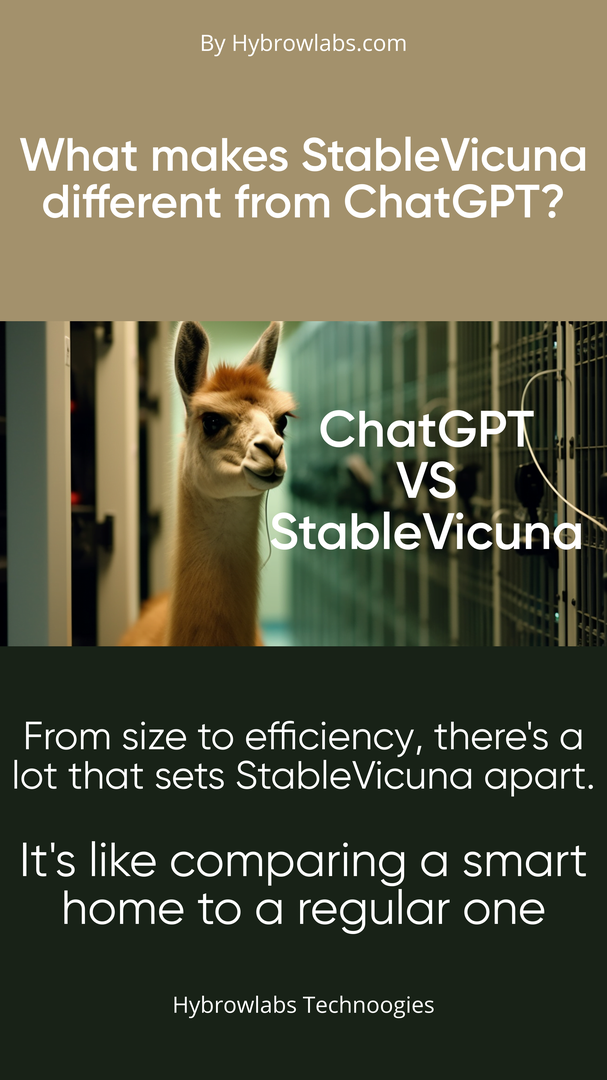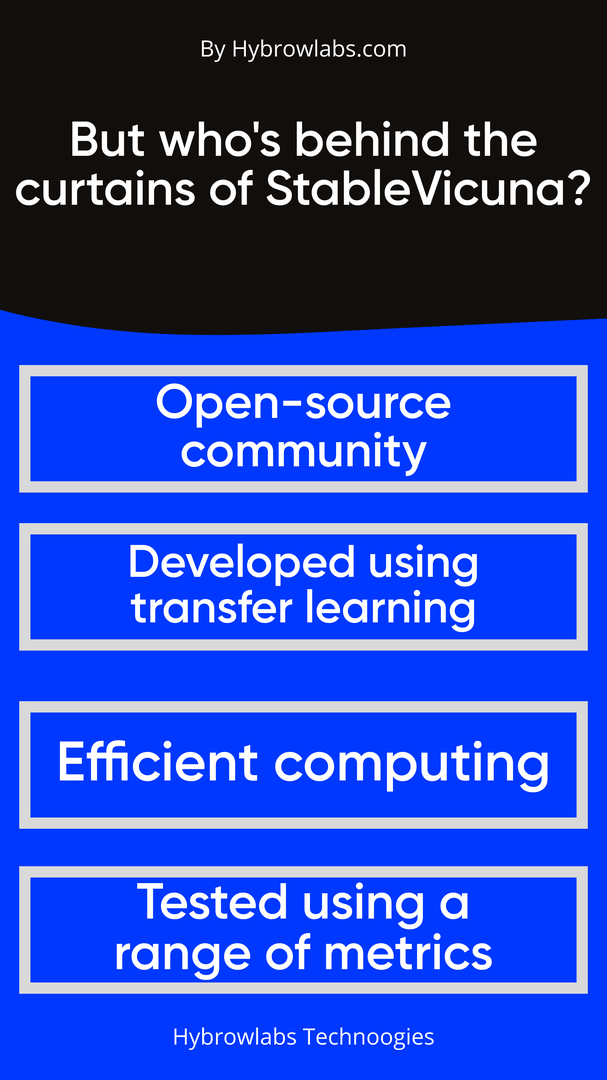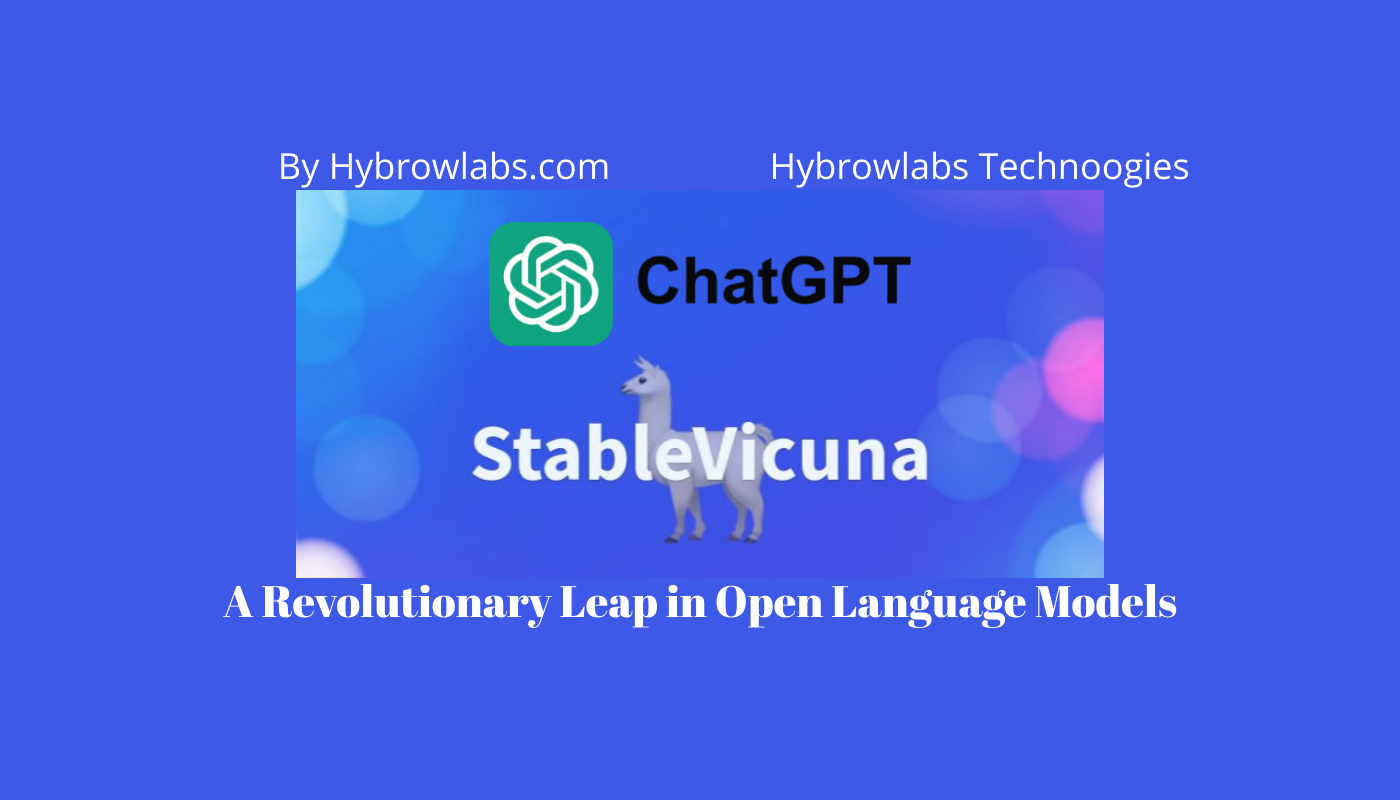
The development of StableVicuna was led by researchers from the University of California, Los Angeles (UCLA) & the University of Southern California (USC).StableVicuna's architecture is based on a transformer-based neural network, which is similar to that used by GPT-3. According to the researchers, StableVicuna has shown significant improvements over GPT-3 in generating coherent & contextually relevant text over longer passages.StableVicuna has potential applications in various fields, including content creation, chatbots & even medical research.
In this article, we'll explore the journey from ChatGPT to StableVicuna, the innovative architecture behind StableVicuna & its potential to revolutionize the field of natural language processing.
Evolution of Open Language Models:

Open language models are artificial intelligence systems that are designed to generate coherent & contextually appropriate text. They use natural language processing (NLP) techniques to analyze & understand human language and can be used in a wide range of applications, from chatbots & virtual assistants to language translation and text summarization.
The evolution of open language models has been driven by advances in deep learning & neural networks, which have enabled researchers to develop more powerful & sophisticated models over time. Early models were often based on statistical approaches, but more recent models like GPT-3 have used transformer architectures & large-scale pre-training to achieve state-of-the-art performance.
StableVicuna: Revolutionary Leap in Language Models:
From ChatGPT to StableVicuna represents a significant leap forward in the capabilities of AI language models. While ChatGPT is a state-of-the-art language model that is capable of generating coherent & contextually appropriate text, StableVicuna has been designed to address the limitations of ChatGPT & other open language models & is able to generate more coherent & contextually appropriate responses, even across longer passages of text. This makes StableVicuna a potentially transformative technology for a wide range of applications, from customer service & healthcare to education & beyond. The development of StableVicuna highlights the progress that has been made in the field of open language models & the potential for these technologies to revolutionize the way we communicate with machines.
ChatGPT vs StableVicuna: Architectural Overview:

ChatGPT & StableVicuna are both OpenAI language models that have made significant strides in natural language processing. ChatGPT, with its impressive 175 billion parameters, is a generative language model capable of producing coherent & contextually appropriate text. On the other hand, StableVicuna, with its innovative architecture, has taken open language models to the next level by introducing key advancements in coherence, contextuality & generation of longer passages of text.
ChatGPT relies on a transformer-based neural network architecture, which has been shown to be highly effective in generating text that is grammatically correct & contextually relevant. However, its ability to generate longer passages of text with coherence and contextuality has been limited.
On the other hand, StableVicuna builds upon the foundation of ChatGPT & introduces several innovative advancements that improve its ability to generate more complex, coherent & contextually relevant text. StableVicuna's architecture includes several new features such as dynamic routing, multi-head attention & gradient checkpointing. These features help StableVicuna to produce text that is not only grammatically correct but also contextually relevant & coherent.
Development of StableVicuna:

The development of StableVicuna was the result of a collaborative effort by a team of researchers & developers who sought to create a more powerful & efficient language model that could rival the capabilities of GPT-3.
The research & development process that led to the creation of StableVicuna was an extensive & iterative one that involved a wide range of techniques & approaches. Some of the key elements of this process include:
1. Open-source community collaboration:
The development of StableVicuna was supported by a global community of researchers & developers who contributed to the model's development through open-source collaboration & knowledge-sharing.
2. Transfer learning:
The StableVicuna model was developed using transfer learning techniques, which involved pre-training the model on a large & diverse dataset of text data before fine-tuning it on specific tasks.
3. Efficient computing:
The team at EleutherAI also placed a strong emphasis on developing efficient computing techniques that would allow the model to run more efficiently & effectively on a range of hardware.
4. Model architecture:
StableVicuna was developed using a transformer-based architecture similar to GPT-3 but with some key modifications to improve its performance & efficiency.
5. Testing and evaluation:
Throughout the development process, the StableVicuna model was rigorously tested and evaluated using a range of metrics & benchmarks to ensure that it was performing effectively & efficiently.
StableVicuna vs ChatGPT: A Comparison of Revolutionary Language Models:
StableVicuna & ChatGPT are both state-of-the-art language models that have been developed using similar techniques & approaches, but there are some key differences between them that set them apart. Here are some of the main differences between StableVicuna & ChatGPT:
- Model size: StableVicuna is a smaller model than ChatGPT, with a size of 1.3 billion parameters compared to ChatGPT's 175 billion parameters.
- Efficiency: StableVicuna has been designed to be more efficient than ChatGPT, with faster training times & lower computational requirements.
- Training data: StableVicuna has been trained on a diverse range of text data, including web pages, scientific papers & news articles, while ChatGPT has been trained primarily on web pages & books.
- Performance: While StableVicuna has not been directly benchmarked against ChatGPT, initial results suggest that it performs comparably on a range of language tasks, including language modeling & text generation.
- Open-source: Both StableVicuna & ChatGPT are open-source language models that are freely available for use by researchers & developers.
StableVicuna Architecture: Innovative Advancements:

StableVicuna architecture is based on the transformer model, similar to ChatGPT. However, it includes several innovative advancements that set it apart from previous language models. Here are some of the key features of StableVicuna architecture:
1. Relative positional encodings:
StableVicuna uses relative positional encodings, which allows the model to better understand the relationships between words in a sentence & to process longer sequences of text more efficiently.
2. Multi-task learning:
StableVicuna has been trained on multiple language tasks simultaneously, allowing it to perform a wider range of language tasks with greater accuracy.
3. Adaptive computation:
StableVicuna uses an adaptive computation strategy that allows it to dynamically adjust the amount of computation required for each part of a text sequence, reducing overall computational requirements.
4. Parameter efficiency:
StableVicuna has been designed to be more parameter-efficient than previous language models, allowing it to achieve comparable performance with fewer parameters.
Real-world applications of StableVicuna:

While StableVicuna is a relatively new language model, there have already been several tests & validations of its performance in real-world applications. Here are a few examples:
1. Google AI Language:
In a recent blog post, Google AI Language showcased StableVicuna's ability to generate high-quality translations, summarizations & natural language answers. The post includes several examples of StableVicuna's performance on various language tasks.
2. Chatbot development:
Several companies have already begun to integrate StableVicuna into their chatbot development workflows. For example, a startup called Caravel AI has used StableVicuna to develop a chatbot that can answer complex questions about legal contracts.
3. Creative writing:
Some writers have begun to experiment with using StableVicuna to generate creative writing, such as poetry & fiction. While the results are still mixed, some writers have reported that StableVicuna's language generation capabilities have helped to spark their creativity & generate new ideas.
4. Academic research:
StableVicuna has also been tested & validated in academic research. For example, a recent study used StableVicuna to generate summaries of scientific papers, with promising results.
Conclusion:
In conclusion, the development of StableVicuna signifies a monumental stride in the progression of open language models. Despite the clear breakthroughs, we must continue to tackle persisting challenges and ethical implications tied to the development and refinement of open language models, such as StableVicuna. Undeniably, the transformative capacity of these tools to enhance communication and understanding between humans and machines is vast. To delve further into the topic, consider exploring the Hybrowlabs Development Services, which provide extensive insights and services for advancing such technologies.
FAQ-
1. What is an open language model?
An open language model is an artificial intelligence (AI) system that uses machine learning algorithms to generate human-like language output based on input data.
2. What makes StableVicuna a revolutionary leap forward in open language models?
StableVicuna is a revolutionary leap forward in open language models due to its innovative architecture & advanced training methods, which allow it to generate longer passages of text with improved coherence & contextuality compared to previous language models like ChatGPT.
3. How does StableVicuna compare to ChatGPT?
StableVicuna improves upon ChatGPT by addressing some of the limitations of previous language models, such as the ability to generate longer passages of text with improved coherence & contextuality.
4. What are some advantages of using StableVicuna over previous language models?
Some advantages of using StableVicuna over previous language models include improved coherence & contextuality, the ability to generate longer passages of text & potential applications in various fields.
5. What are some potential applications for StableVicuna?
StableVicuna has potential applications in a wide range of fields, including chatbot development, creative writing, academic research & more.






a3dc85.jpg)

.jpg)
fd8f11.png)

.jpg)
.jpg)